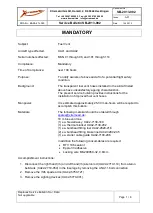
Initial issue
Page 7-3
7.1
General
This chapter provides a description and operation of the aircraft and its systems. Some equipment, primarily avionics
is not described in this section. For detailed description and operation of this equipment refer to OEM manual.
7.2
Airframe
Fuselage
The fuselage structure consists of glass and carbon fiber sandwich composite, that produces a smooth and seamless
surface. The structure is stiffened using firewall, bulkheads, ribs, stiffeners and interior components creating the
cockpit. Major items of the structure are main and auxiliary spars to which the wings are attached. Each wing is
attached to the fuselage by means of two main pins and one auxiliary pin.
The cockpit is limited by a firewall in the front and backrest in the rear. In the middle of the cockpit there is a center
tunnel which divides the cockpit for left and right side. The cockpit provides seating for two adults and the seats are
arranged side by side. The cockpit is non-pressurized.
The baggage compartment is located between the backrest and baggage compartment bulkhead. The baggage
compartment is divided in two sections by a center tunnel.
The rear windows are located on both sides above the baggage compartment area.
Integral fuel tanks are located in the forward box of the wing center section on the left and right side of the fuselage.
Wing
The wing consists of glass and carbon fiber sandwich composite, that produces a smooth and seamless surface.
The construction of the wing includes conventional design with main spar, rear shear web, root rib and fuel tank ribs.
The upper and lower skins are bonded to the spars, ribs and rear shear web. Wing spar, rear shear web and skins form
two torsion boxes. The wing tip is fitted a winglet.
The wing main spar is attached to the center section spar by means of two main pins. The rear shear web of the wing
is attached to the auxiliary spar by means of one auxiliary pin.
There are integral fuel tanks situated in the forward box of the wing root section in both wings. The wing fuel tanks
are connected to the fuselage fuel tanks by a simple hose connection. The wing and fuselage tanks are also
conductively connected.
Stall strips, which improve the stall characteristics are installed on the wing leading edges.
Empennage
The conventional cruciform tail consists of a vertical stabilizer with a rudder, and horizontal stabilizer with elevator.
The vertical stabilizer consists of glass and carbon fiber sandwich composite. The construction of the vertical stabilizer
includes skin, rear web and tip rib. The vertical stabilizer is an integral part of the fuselage. The rudder is attached to
the vertical stabilizer’s rear
web by means of three hinges.
The horizontal stabilizer consists of glass and carbon fiber sandwich composite. The horizontal stabilizer is a single
composite structure from tip to tip. It is bonded to the fuselage. The construction of the horizontal stabilizer includes
upper and lower skin, partial span middle webs, rear web and root ribs. The two-piece elevator is attached to the
horizontal stabilizer rear web by means of four hinges and one center hinge.
Содержание WT9 Dynamic LSA / Club
Страница 2: ...This page is left blank intentionally...
Страница 4: ...Page B Initial issue This page is left blank intentionally...
Страница 8: ...Page F Initial issue Chapter Page Date Chapter Page Date...
Страница 10: ...Page H Initial issue This page is left blank intentionally...
Страница 20: ...Page 1 4 Initial issue Three View Drawing Fig 1 1 Three view drawing...
Страница 94: ...Page 4 28 Initial issue This page is left blank intentionally...
Страница 109: ...Initial issue EASA Approved Page 5 15 Fig 5 2 Crosswind U S Standard Units...
Страница 110: ...Page 5 16 EASA Approved Initial issue This page is left blank intentionally...
Страница 119: ...Initial issue EASA Approved Page 6 9 Fig 6 2 Operating Weight CG limit Metric Units...
Страница 120: ...Page 6 10 EASA Approved Initial issue Fig 6 3 Operating Weight CG limit U S Standard Units...
Страница 122: ...Page 6 12 EASA Approved Initial issue Fig 6 4 Check of flight weight moment limits Example Metric Units...
Страница 125: ...Initial issue EASA Approved Page 6 15 Fig 6 5 Weights and moments of variable masses chart Metric Units...
Страница 127: ...Initial issue EASA Approved Page 6 17 Fig 6 6 Weights and moments of variable masses chart U S Standard Units...
Страница 134: ...Page 6 24 EASA Approved Initial issue This page is left blank intentionally...
Страница 148: ...Page 7 14 Initial issue Fig 7 5 Arrangement screen 1 Fig 7 6 Arrangement screen 2...
Страница 149: ...Initial issue Page 7 15 Fig 7 7 Arrangement screen 3 Fig 7 8 Arrangement screen 4...
Страница 150: ...Page 7 16 Initial issue Fig 7 9 Arrangement screen 5 Fig 7 10 Arrangement screen 6...
Страница 162: ...Page 7 28 Initial issue Fig 7 16 Arrangement screen 1 Fig 7 17 Arrangement screen 2...
Страница 163: ...Initial issue Page 7 29 Fig 7 18 Arrangement screen 3 Fig 7 19 Arrangement screen 4...
Страница 164: ...Page 7 30 Initial issue Fig 7 20 Arrangement screen 5 Fig 7 21 Arrangement screen 6...
Страница 165: ...Initial issue Page 7 31 Fig 7 22 Arrangement screen 7 Fig 7 23 Arrangement screen 8...
Страница 173: ...Initial issue Page 7 39 Fig 7 29 Air outlets for cockpit venting Fig 7 30 Windshield demist knob...
Страница 178: ...Page 7 44 Initial issue This page is left blank intentionally...
Страница 188: ...Page 8 10 Initial issue Fig 8 5 Fuel draining...
Страница 198: ...Page 8 20 Initial issue This page is left blank intentionally...
Страница 204: ...Page 9 6 Initial issue This page is left blank intentionally...
















































